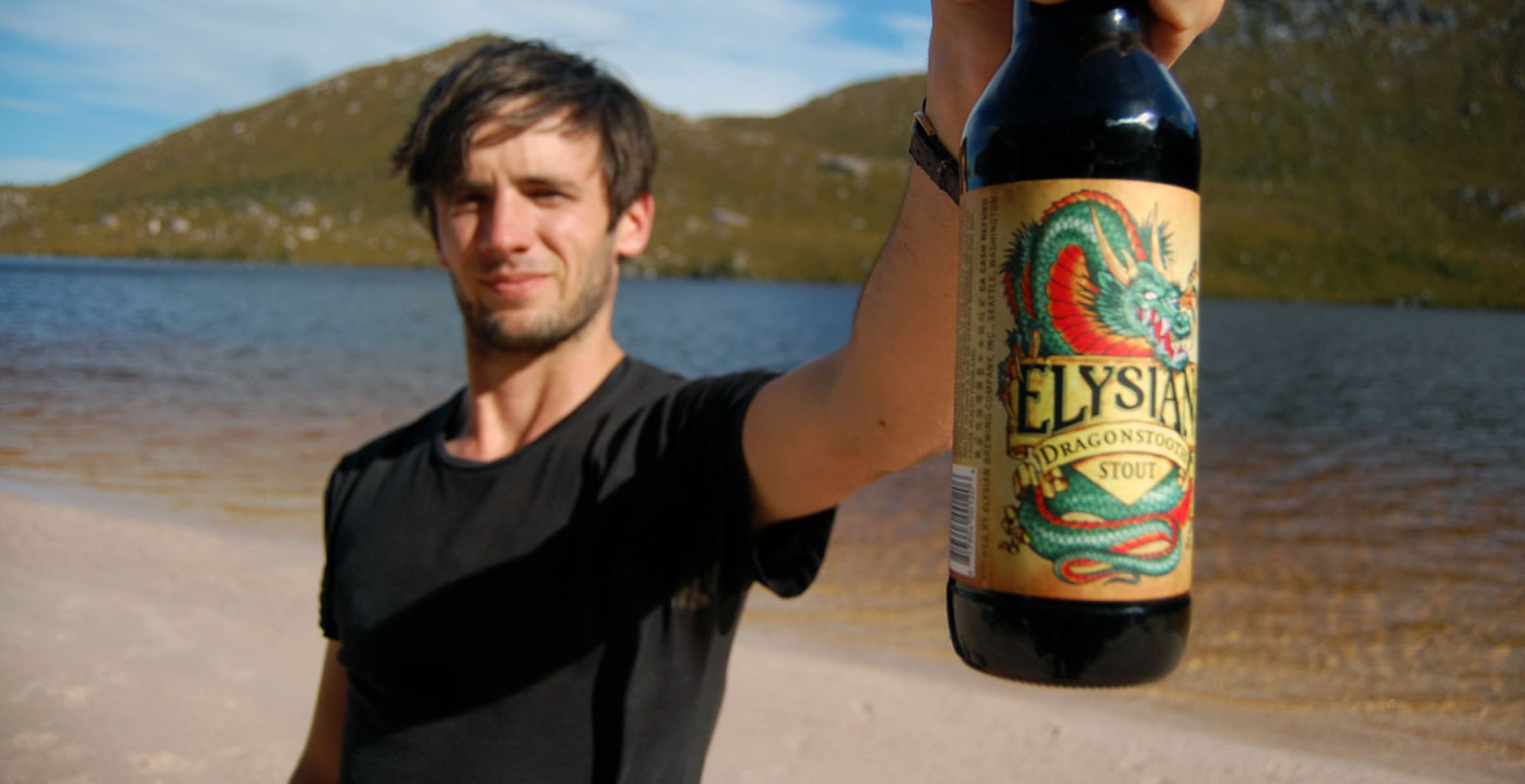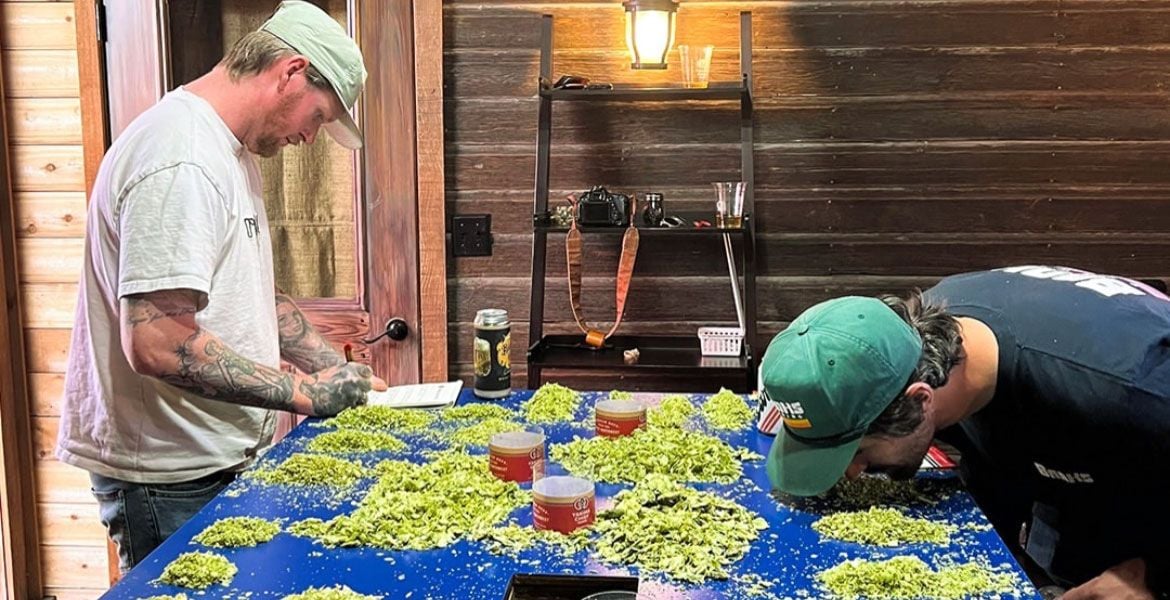Having returned to his home in Tasmania after touring the outer reaches of Northern Europe, whence he experienced beer in the Scottish Isles, Iceland and Copenhagen, wandering storyteller Bert Spinks has been out bushwalking.
Here, he ponders the whys and wherefores of doing it with beer.
This week I went bushwalking with two of my dearest mates: a couple of intellects, eccentrics, athletes, and happy drinkers. Summer approaches, and along with the barbies, beaches and cricket games, going bush is still a bit part of the seasonal routine in Tasmania where we live. So, even though the weather looked patchy, we thought we’d go and disappear for a night out in the forest.
Part of the joy of being in the bush is the manner in which you can strip back to simplicity. Your whole life fits in your backpack. There are few furnishings: your entertainment might be a pack of cards or a squash ball; your food supplies are limited; your electronic connections are zero. But that doesn’t mean you have to go without a beer.
I work as a bushwalking guide in the mountains of Tasmania, and although I would never drink from my own private stash of booze whilst in a professional capacity, I suppose I have enough experience to offer some advice (and anecdotes) on the theme of bushwalking and beer.
Some may suggest that with the weight of a tent, sleeping bag, sleeping mat, stove, clothing and victuals on your back, it’s a little foolish to lug bottles of beer along with it. I heartily disagree. The experience of uncapping a good craft brew at the end of a day’s strolling is worth whatever exhaustion you’ve put yourself through carrying it. It’s important to have something to look forward to at the end of the day, either to cap off a great day’s sauntering or (if it’s been a tough hike) to maintain your morale for the next day.
Certainly there is no reason why you can’t complement your assortment of beers with something stronger, like port or whisky, but don’t dismiss the beers altogether.
Some local bushwalkers have been known to carry several litres of beer into the mountains. I will leave it up to the reader’s discretion how much extra weight they think they can carry, and how much booze they reckon they need.
Cans can be good, being lighter than glass bottles, although they come with a risk. A mate of mine ended up with a sleeping bag drenched in scotch ale after two cans of Devil's Canyon Full Boar inexplicably imploded. The aroma of caramel malts stuck to the down for weeks (not such a bad result, mind you).
I have also had it recommended to me that I consider filling a bladder with a nice mild ale, but am yet to try it myself. Certainly I do not advise replacing your water supply with beer, for health reasons.

If you’re going to be pitched up next to a creek, river or lake for the night, there’s no reason not to bring some nice ales. Even if the contents get very warm throughout the day, they can be cooled quickly enough in the water. One of my favourite evenings (perhaps of my whole life) was sharing a bottle of Stillwater Existential farmhouse ale under a rising moon; it had been cooled in a little spring near a favoured camping spot in the Tasmanian mountains. On another wonderful occasion, I came towards the end of a ten-day wander along the island’s south coast to find a mate waiting for me with a bunch of bananas and an assortment of ales floating in the rivulet.
Stouts are a sensible option too, especially if you’re not sure that you’ll be able to chill your drinks. Rich, chocolaty ones – Mikkeller’s George! comes to mind – are good options. Although in cold weather, the opposite can occur, and a stout can become over-chilled. Once, in the autumn with a bottle of Evil Twin’s decadent “Lil’ B” (a beer that really deserves to be a little warm to have full appreciation of the flavour), an ingenious friend tried to get a bit of warmth into it by boiling water and putting the tin cups of stout into the pot. Of course, the tin cups absorbed all the heat and it was impossible to put one’s lips to it for a good while, but it worked out in the end: a stout at the right temperature, and a bloody fine one to have on a cool night at that.
Don’t forget to bring something to drink out of, either. One memorable beer-in-the-bush occurred in Pine Valley, in the midst of Tassie’s rainforest wilderness. We had thrashed through some nasty scrub to arrive at a little hut in the last throes of twilight. A quick dinner was constructed and then the evening’s brew was extracted from a backpack: Moon Dog’s Jumping the Shark 2014, the saffron-infused imperial red ale probably designed to send the brewery bankrupt. It was a generous beer to bring and I, having forgotten my cup, drank the expensive beer liqueur from an aluminium cooking pot – much to the dismay of my companion.
(True to form, though, when I ran into the Moon Dog brewers a couple of days later at a beer festival in Hobart, they declared it “fucken awesome” that this had been their product’s fate.)
It’s also important to be careful with your beverages. If you go tumbling down some scree, for example, your bottles can smash. And if you knock over a cup or a bottle, there may be no replacing its precious contents. Although I did hear an example of a particular Japanese coffee stout being spilled into the concave hollow of a rock and lapped at, like a cat. “Almost nothing was lost,” I was assured.
The bushmen of old usually didn’t mind a drink. Tasmanian folklore is full of characters who spent months at a time in solitude and privation, but loved a social tipple every so often. Some were home brewers. Ernie Bond’s hospitality in the Gordon River rainforest was so great he convinced a Quaker teetotaller to try his dodgy home brew. Bert Ferguson of Lake St Clair, a war veteran with a steel plate in his noggin, used to make an ale using the leaves of the sassafras tree found in rainforests in south-east Australia. Another great personality was Paddy Hartnett: tough as nails, a good yarn-spinner and a loveable failure, Paddy was a hunter in the highlands in the winter, and a regular at the pub in Mole Creek (which is still worth a visit).

Paddy’s abode in the mountains – a pine hut named “Windsor Castle” (pictured above) – was no doubt its own fine drinking establishment, so, one night in the mountains, I met up near there with a few fellow mountain men. An impressive quantity of flasks and bottles were produced, and all present sampled from each one of them. One of our cohort, Jugs Clark, had hauled up a real beauty: Brooklyn’s Local No. 2, a big tall bottle of dark Belgian strong ale. It wasn’t exactly what Paddy Hartnett would have imbibed, but we reckon he’d have been pleased to join us.
Likewise, this past week, between pitching tents and cooking spuds, a rigorous climb up the side of a mountain, and the invention of a complicated sport that involved throwing a stick to each other, there were beers. Good ones. Seven Sheds’ Kentish Ale (we were in the area), the wonderful muscat barrel-aged Barley Wine from Van Dieman, Siren Brewing’s Uncle Jester sour citrus braggot. The rain tumbled down on our tents as we poured out portions into each other’s cups and raised a toast to another rambling summer.
Because the truth is, for this correspondent, part of the charm of craft beer is that each individual concoction is a place for stories to overlap. Each brew has, for its makers, a long history from conception to creation; and likewise, for each drinker, there is a matrix of yarns on top of it. It’s a great feeling to stand in front of a shelf of craft beers, pointing and saying, “Remember when we had this into Junction Lake? Didn’t we take that up to Stacks Bluff?”
Or, “Did you hear that Gilly slurped this espresso stout off the ground after climbing Federation Peak?”
Bert's Bushwalking Beer Recommendations
- Hailing from ramblers’ country in the UK, Theakston’s Old Peculiar ale is a personal favourite of one of the rangers around Tasmania’s Cradle Mountain.
- On a solo stroll in the mountains I once carried a bottle of La Sirène’s Farmhouse Red, cooled it in the creek, and drank it alone beneath a bright moon and between several seriously-silhouetted summits. Très jolie.
- John Muir is one of history’s most heroic hikers, and his favourite neck of the woods was the Sierra Nevada in California. Therefore it’s only appropriate to recommend the “Narwhal” stout from brewery of the same name if you find yourself benighted in the mountains.
- Taking a percolator for your little camping stove is also recommended: coffee is another pleasant brown liquid to have in the bush. But, if you aren’t taking one, perhaps a coffee-infused brew will suffice? Haandbryggeriet’s Costa Rica has been enjoyed by this writer on a bushwalk, although the 8 Wired Flat White Stout might give you your fix of popular coffee styles while you’re far from your favourite hipster alleyway café.
But enough from me: what do you reckon?
About the author: Bert Spinks somehow makes a living from writing, walking and drinking.
Top: William – now co-owner of DuCane Brewing in Launceston – proudly holds the evening's stout aloft at Lake Rhona
Inset: Amalia swigs from a can of creek-cooled Pirate Life Pale Ale













